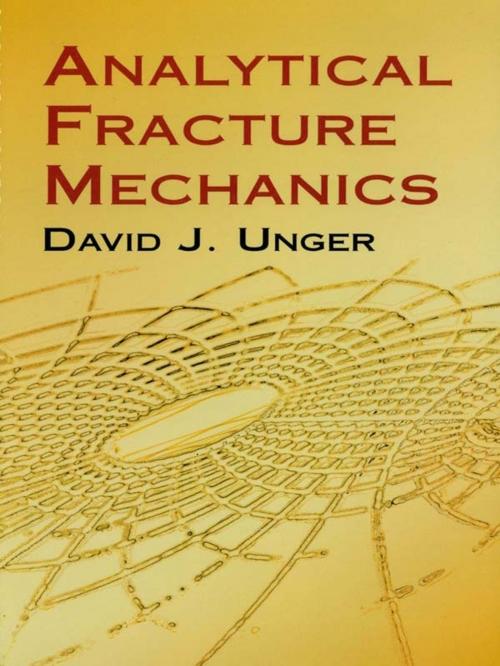| Author: | David J. Unger | ISBN: | 9780486143859 |
| Publisher: | Dover Publications | Publication: | June 8, 2012 |
| Imprint: | Dover Publications | Language: | English |
| Author: | David J. Unger |
| ISBN: | 9780486143859 |
| Publisher: | Dover Publications |
| Publication: | June 8, 2012 |
| Imprint: | Dover Publications |
| Language: | English |
"Analytical Fracture Mechanics should prove to be a valuable resource to both the new student and the experienced researcher in fracture mechanics. It is recommended." — Applied Mechanics Review
One of the central concerns of engineering is the failure of materials. Addressing this concern, fracture mechanics — an interdisciplinary subject spanning mechanical, civil, and materials engineering, applied mathematics, and physics — predicts the conditions under which such failure will occur due to crack growth. This valuable self-contained text by an expert in the field supplements standard fracture mechanics texts by focusing on analytical methods for determining crack-tip stress and strain fields.
Following a comprehensive 120-page introduction — which provides all the background necessary for understanding the remaining chapters — the book is organized around a series of elastoplastic and hydrogen-assisted crack-tip problems and their solutions. The first chapter presents the only proven solution technique for the second order nonlinear partial differential equation governing a mode I elastoplastic crack problem. Other chapters deal with plastic zone transitions, environmental cracking, and small-scale yielding versus exact linear elastic solutions.
One of the excellent features of this book is the clarity with which groups of problems are presented and related to each other. Another is the careful attention it gives to the various modes of fracture (I, II, and III) and to showing the circumstances under which information from a solution for one mode may be used to infer information in another mode. For this edition, the author has added a new appendix, "Stress Across an Elastoplastic Boundary of a Mode I Crack: Parabolic to Hyperbolic Plasticity Transition."
"Analytical Fracture Mechanics should prove to be a valuable resource to both the new student and the experienced researcher in fracture mechanics. It is recommended." — Applied Mechanics Review
One of the central concerns of engineering is the failure of materials. Addressing this concern, fracture mechanics — an interdisciplinary subject spanning mechanical, civil, and materials engineering, applied mathematics, and physics — predicts the conditions under which such failure will occur due to crack growth. This valuable self-contained text by an expert in the field supplements standard fracture mechanics texts by focusing on analytical methods for determining crack-tip stress and strain fields.
Following a comprehensive 120-page introduction — which provides all the background necessary for understanding the remaining chapters — the book is organized around a series of elastoplastic and hydrogen-assisted crack-tip problems and their solutions. The first chapter presents the only proven solution technique for the second order nonlinear partial differential equation governing a mode I elastoplastic crack problem. Other chapters deal with plastic zone transitions, environmental cracking, and small-scale yielding versus exact linear elastic solutions.
One of the excellent features of this book is the clarity with which groups of problems are presented and related to each other. Another is the careful attention it gives to the various modes of fracture (I, II, and III) and to showing the circumstances under which information from a solution for one mode may be used to infer information in another mode. For this edition, the author has added a new appendix, "Stress Across an Elastoplastic Boundary of a Mode I Crack: Parabolic to Hyperbolic Plasticity Transition."















